Study on the technology of brewing red raspberry wine by using new immobilized yeast technology
Optimization of preparation conditions for immobilized yeast
Carbon source optimization
The type of carbon source added has an effect on the size of the immobilized yeast and the clarity of the medium (Table 3). The diameters of the immobilized yeast from large to small were lactose, glycerol, gluconic acid, glucose, and sucrose. At the same time, the larger the diameter, the smaller the number of immobilized yeast. The carbon source had no obvious effect on the surface state of the immobilized yeast, and the surface of the immobilized yeast with different carbon sources is smooth. However, different carbon sources had an effect on the clarity of immobilized yeast culture medium. When using glucose, sucrose, and glycerol, the medium is cloudy because the carbon source used is suitable for yeast growth11. Simultaneously yeast overgrowth causes the medium to be cloudy and inhibits the growth of P. chrysogenum. When lactose is used, the medium is yellow, while when gluconic acid is used, the medium is clear and normal. Therefore, considering the growth state of immobilized yeast, gluconic acid is determined as the best carbon source.
Optimization of nitrogen source
The type of nitrogen source added affects the size of the immobilized yeast and the surface state of the immobilized yeast (Table 4). The diameters from large to small are urea, peptone, yeast extract, (NH4)2SO4, KNO3. Consistent with the effect of adding different carbon sources on immobilized yeast, the larger the diameter, the less the number of immobilized yeast. The immobilized yeast surface was rough when urea and peptone were used, indicating that nitrogen sources could affect the surface state of immobilized yeast. Based on the diameter and surface state of immobilized yeast, yeast extract was determined as the best nitrogen source.
Optimum dosage of Penicillium chrysogenum spores
The mycelium of P. chrysogenum, as the carrier of immobilized yeast, has a direct impact on the preparation of immobilized yeast12. The size of the immobilized yeast is different due to the different amount of P. chrysogenum spores added are 6 × 104 cfu/ml > 1 × 105 cfu/ml > 6 × 105 cfu /ml > 1 × 106 cfu/ml > 6 × 106 cfu/ml (Table 5). The addition amount of P. chrysogenum can affect the diameter and number of immobilized yeast13. In terms of the number of immobilized yeasts, the more P. chrysogenum spores are added, the more immobilized yeasts will be. When the amount of spores added is large, more spores can interact with the yeast in a unit volume and can interact quickly, so it is easier and faster to form more immobilized yeasts with small diameters. On the other hand, because the number of yeasts is basically constant, the more spores of P. chrysogenum are added, the less yeast can be effectively encapsulated by each immobilized yeast, and the volume is small. The medium with each concentration of P. chrysogenum spores was in a clear state and the surface was smooth, indicating that the addition of P. chrysogenum spores had no effect on the clarity of the medium, that is, the surface state of the immobilized yeast. Considering the quantity and size of immobilized yeast, the optimal spore addition range is 1 × 105 cfu/ml ~ 6 × 105 cfu/ml.
Orthogonal experiment
Based on the above, it is determined that the optimal carbon source is gluconic acid, the optimal nitrogen source is yeast extract, and the optimal addition amount of P. chrysogenum spores is 1 × 105 cfu/ml ~ 6 × 105 cfu/ml. Orthogonal optimization of the preparation conditions of immobilized yeast based on the optimal carbon source, nitrogen source and the addition amount of P. chrysogenum spores determined by single factor, design three-factor three-level orthogonal test of factors, the test level is shown in Table 6.
The factors affecting the number of encapsulated bacteria in immobilized yeast were B > A > C, and the factors affecting the number of leaking bacteria in immobilized yeast were C > A > B. According to the orthogonal results (Table 7), when the diameter is used as the selection standard, the optimal combination is A2B2C1, namely No. 5. When the number of encapsulated bacteria is used as the selection criterion, the optimal combination is A2B1C3, namely No. 4. When the number of leaking bacteria was used as the selection criterion, the optimal combination was A2B2C1, namely No. 5.
Effects of mechanical strength of immobilized yeast
Immobilized yeast will be subjected to different mechanical forces during the fermentation process, resulting in crushing damage or scraping damage14, so the mechanical strength of immobilized yeast has an important impact on the performance and repeatability of immobilized yeast. The two groups of optimal combinations obtained from the optimized orthogonal test of immobilized yeast, the test groups No. 4 and No. 5, were tested for mechanical strength (Fig. 1a,b). The comparison between the two was shown in Fig. 1c. It can be seen that the hardness of No. 4 is 0.105 N and the elasticity is 0.135 mm. The hardness of No. 5 is 1.29 times that of No. 4, and the elasticity is 1.5 times that of No. 4, which are 0.135 N and 0.207 mm, respectively.
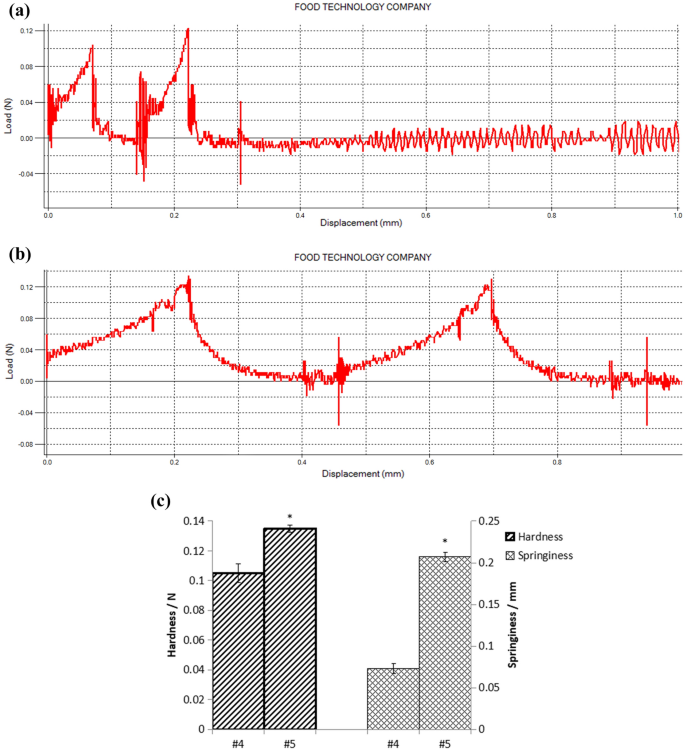
(a) Texture map of the 4th group of immobilized yeast. (b) Texture map of the 5th group of immobilized yeast. (c) Hardness and springiness of immobilized yeast.
Therefore, the optimal immobilized yeast was determined as the No. 5 test group, with 5 g/L of gluconic acid, 5 g/L of yeast extract, and 1 × 105 cfu/ml of P. chrysogenum spores.
Comparison between immobilized yeast and free yeast
Comparison of fermentation performance
The results of residual sugar and alcohol content of red raspberry wine brewed by immobilized yeast and free yeast are shown in Fig. 2a,b. It can be seen that the residual sugar content of free yeast is slightly higher than that of immobilized yeast, and the sugar consumption rate of immobilized yeast is higher than that of free yeast, indicating that the fermentation rate of immobilized yeast is higher than that of free yeast.
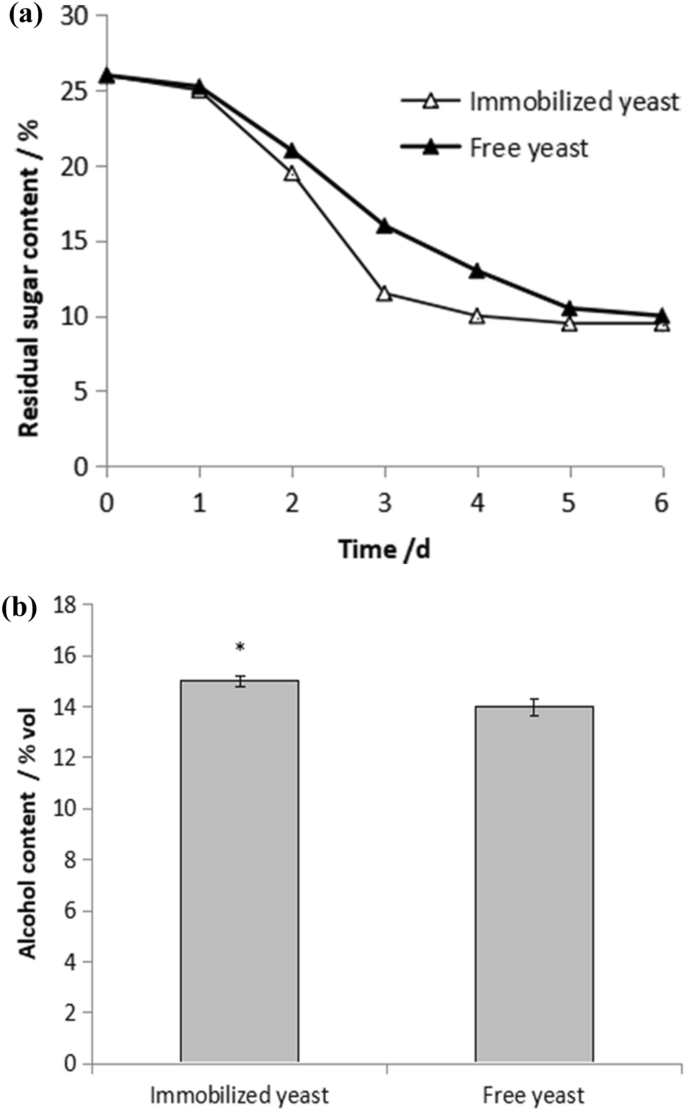
(a) Comparison of residual sugar content change between free yeast and immobilized yeast. (b) Comparison of alcohol content between free yeast and immobilized yeast.
The alcohol content of red raspberry wine brewed by immobilized yeast is 15% vol, and it brewed by free yeast is 14% vol. It was also proved that with the same inoculum amount, the fermentation ability of immobilized yeast was better than that of free yeast.
Comparison of ingredients in brewing red raspberry wine
The total acid, anthocyanin, reducing sugar and polyphenol content of red raspberry wine brewed with immobilized yeast and free yeast were analyzed.
It can be seen that the total acid content of the red raspberry wine brewed by immobilized yeast is 1.0438%, which is lower than 1.3687% of the red raspberry wine brewed by free yeast (Fig. 3a). That is, the acidity of red raspberry wine brewed by immobilized yeast is lower than that of free yeast, and the taste of red raspberry wine brewed by immobilized yeast is also better than that of free yeast.
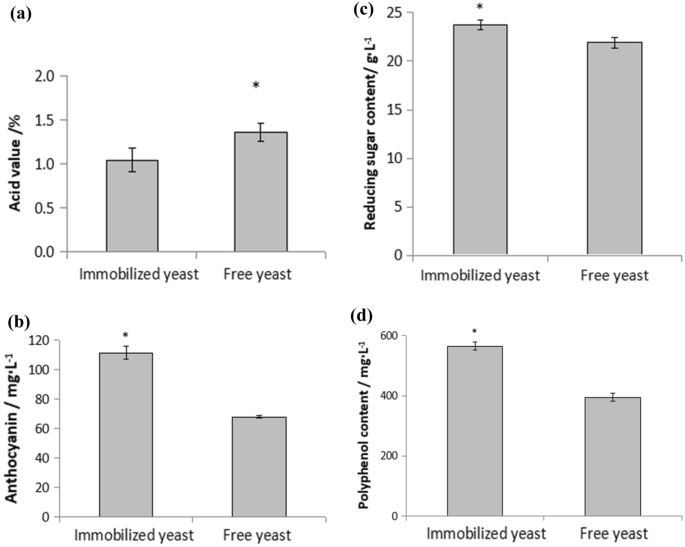
(a) Comparison of acid value between immobilized yeast and free yeast. (b) Comparison of anthocyanin content between immobilized yeast and free yeast. (c) Comparison of reducing sugar between free yeast and immobilized yeast. (d) Comparison of polyphenol content between free yeast and immobilized yeast.
The anthocyanin content of immobilized yeast brewed red raspberry wine was 111.604 mg/L, the reducing sugar content was 23.73 g/L, and the polyphenol content was 565.67 mg/L; the red raspberry wine brewed by free yeast was 68.020 mg /L, 21.93 g/L, 395 mg/L respectively (Fig. 3b,c,d).The reducing sugar content of red raspberry wine brewed by free yeast and immobilized yeast has little difference, but the content of anthocyanins and polyphenols in immobilized yeast is higher. It shows that immobilized yeast can better retain the active components of red raspberry wine compared to free yeast.
Comparison of aroma components in brewing red raspberry wine
Figures 4 and 5 for the GC–MS total ion efflux of aroma components in immobilized yeast and free yeast fermented red raspberry wine. A total of 40 main aroma components were detected in the two red raspberry wines, including 5 alcohols, 21 lipids, 3 acids, 3 alkenes, 3 aldehydes and ketones, 1 phenol, and 4 others. The two red raspberry wines have the same 22 kinds of aroma components, mainly alcohols and esters.
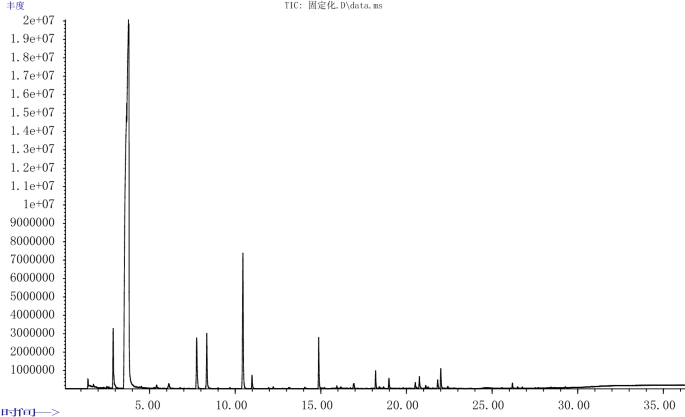
GC–MS total ion outflow Figure of aroma components of red raspberry wine fermented with Immobilized yeast.
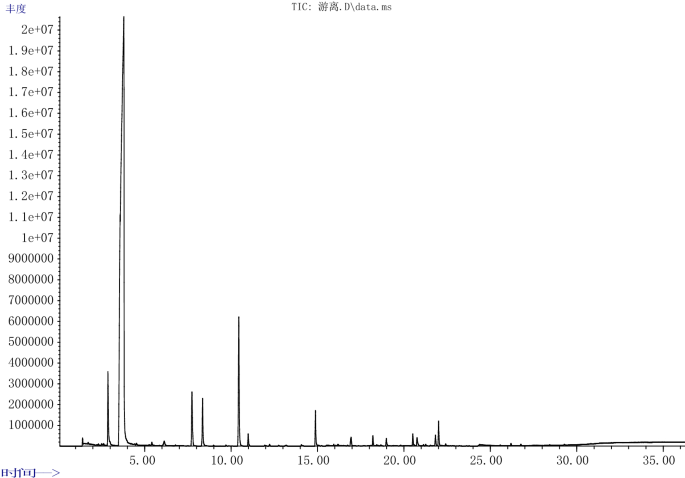
GC–MS total ion outflow Figure of aroma components of red raspberry wine fermented with free yeast.
It can be seen from Table 8 that the main aroma components of the red raspberry wine brewed by immobilized yeast from high to low are isoamyl alcohol 6.8312%, isobutanol 2.8885%, ethyl acetate 2.7084%, isoamyl acetate 2.5946%, ethyl caprylate 2.0175%. The main aroma components of red raspberry wine brewed with free yeast from high to low are isoamyl alcohol 6.0499%, ethyl acetate 2.8018%, isobutanol 2.7780%, isoamyl acetate 2.0802%, ethyl caprylate 1.3425%.
The most abundant aroma component in both raspberry wines was isoamyl alcohol. The total alcohol content of red raspberry wine brewed by immobilized yeast was 11.3627%, which was higher than that of free yeast brewed red raspberry wine 10.6472%. The lipid content of the red raspberry wine brewed with immobilized yeast was 10.0166%, which was higher than that of the red raspberry wine brewed with free yeast, which was 8.6791%. Compared with free yeast fermentation (Fig. 6), immobilized yeast can significantly increase the ester content15. Other studies have also shown that the use of immobilized yeast for fermentation can promote the production of aroma compounds such as alcohols and esters9. In addition, the immobilized yeast also effectively reduced the content of volatile acids, which was beneficial to the quality maintenance of red raspberry wine16.
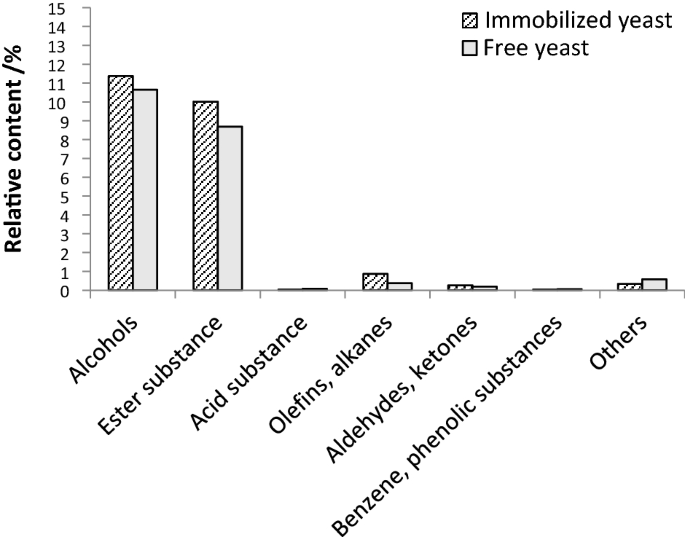
Aroma composition of red raspberry wine fermented with Immobilized yeast or free yeast.
Continuous fermentation performance of immobilized yeast
Figure 7a,b show the changes of residual sugar content and alcohol content of immobilized yeast for three consecutive fermentations. From the results, the residual sugar content of three consecutive fermentations was 9.5%, 10%, and 10.5%, respectively. Alcohol content the degrees were 15% vol, 14.5% vol, and 14.2% vol. With the increase of fermentation times, the residual sugar content increased slightly, and the alcohol content decreased slightly, but the changes were not obvious, indicating that the immobilized yeast of P. chrysogenum maintained good fermentation performance after three consecutive fermentations.
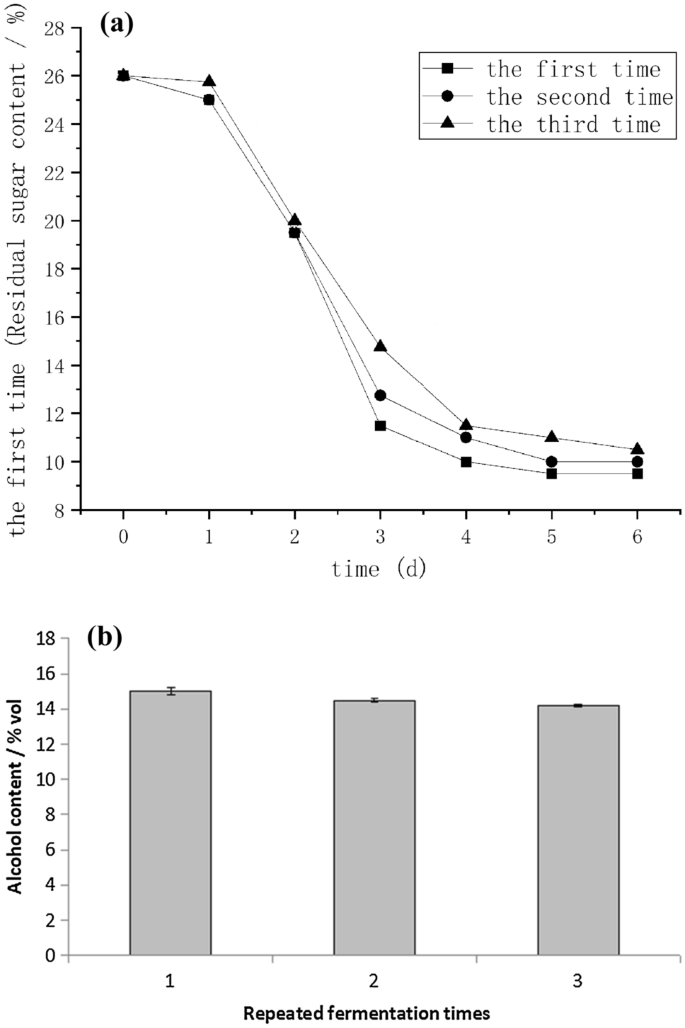
(a) Residual sugar change in continuous fermentation of immobilized yeast. (b) Alcohol change in continuous fermentation of immobilized yeast.








Gloss